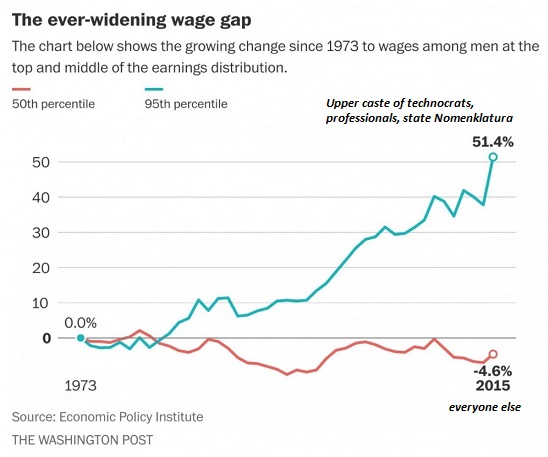笨狼發牢騷
發發牢騷,解解悶,消消愁經濟效率(Productivity)的定義,參見美國經濟的心病。
以前數次提到近來多年美國經濟效率一直停滯不前,成了經濟學家的心病:
美國經濟的幾個怪現象
美國那日落黃昏的製造業崗位
美國經濟效率文集
也是經濟學家難以理解的難題。
最近有人把這歸咎為美國急功近利,用虛的把自己給坑了:
經濟效率1972年既已達頂峰:

原因是什麽?是“經濟轉型”轉到了“金融手腕”(Financial Engineering),用手腕成了經濟的主要動力:

此文還諷刺當今“數碼經濟”,“互聯網時代”,說是大家與世界“接連”的時間大增,知識效率都大幅提高,但誰說大家不是去打遊戲聊天兒了?

要證明嗎?今天美國勞工統計局公布今年一季美國經濟效率,傷心。
《彭博》U.S. Worker Productivity Hasn't Been This Bad Since 1993: Chart

《彭博》報道的標題就把情形點明了(《巴倫周刊Barron's》的標題也太逗了:Productivity Declines in Q1 as Job Market Grows Faster than Economy)。
效率低時有代價的,如《華爾街日報》報道(見下),低效率,低增長,低收入,百姓就沒好日子,就怨恨。

不過也有“有大誌”的要解決這難題:
《華郵博文》The productivity slump and what to do about it
作者Jared Bernstein, a former chief economist to Vice President Biden, is a senior fellow at the Center on Budget and Policy Priorities,是個經濟學家了。一大堆經濟術語後,他說三個辦法:
(一)資本都被吳用了,用到金融業上,還是最糟的那部分(上麵那諷刺也不離譜啊),得重新分布;
(二)想法子增加就業,迫使企業再想法提高效率
(三)將目前功能失調的政府翻個個,改過來
好。大家就等著習近平那樣的英明領袖吧。
難道他是淳樸?
《華爾街日報》U.S. Productivity Fell 1%, Signaling Tepid Growth
Wage growth showed some progress as hourly compensation increased at a 3.0% annual rate
WASHINGTON—U.S. worker productivity fell in the first quarter, but wage growth advanced as a streak of solid job gains continued.
The productivity of nonfarm workers, measured as the output of goods and services for each hour worked, decreased at a 1.0% seasonally adjusted annual rate in the first quarter, the Labor Department said Wednesday. From a year earlier, productivity was up 0.6%.
Economists surveyed by The Wall Street Journal had forecast a 1.4% decline from the prior quarter.
Wage growth showed some progress. Hourly compensation increased at a 3.0% annual rate compared with the prior quarter. That comes after hourly compensation grew a revised 0.9% in the fourth quarter, and could be a signal that a tightening job market may be putting pressure on employers to better pay packages.
A gauge of compensation costs, unit labor costs, increased at a 4.1% annual rate in the first three months of the year—the sharpest rise in more than a year and well ahead of the 3.3% rise economists expected. From a year earlier, unit labor costs rose 2.3%.
Paul Ashworth, chief U.S. economist at Capital Economics, said the increase in labor costs illustrates that “even if economic growth is lackluster, domestic price pressures are still mounting.”

Wednesday’s data marked the fourth decline in productivity in the past six quarters, reflecting the trend of slowing productivity gains since the recession typified by relatively strong hiring but also hesitant business investment and slowing output.
Productivity, an important determinant of an economy’s long-term health and prosperity, has averaged 0.8% over the past four quarters and 0.6% over the past five years. The last similarly weak stretch was in the early 1980s—a worrying signal for the broader economy, which barely managed to eke out growth in the first quarter.
Gross domestic product, the broadest measure of goods and services produced across the economy, increased at a tepid 0.5% seasonally adjusted annual rate in the first three months of the year, according to a Commerce Department release last week. Business spending crashed, while exports tumbled and consumers showed signs of caution.
Low productivity growth slows the economy since it holds down companies’ profits and the wages they can pay workers. That is a concern for the Federal Reserve since weak wage growth can hold down inflation, and inflation has already undershot the central bank’s 2% target for nearly four years.
The economy has continued to produce jobs despite anemic output growth, in part because firms are hiring more workers to compensate for soft growth in worker productivity.
Fed officials expect the pattern to continue, according to projections released earlier this year. They see the jobless rate, which was 5.0% in March, retreating to 4.7% by the end of this year and 4.5% through 2018, lower than previously expected.




